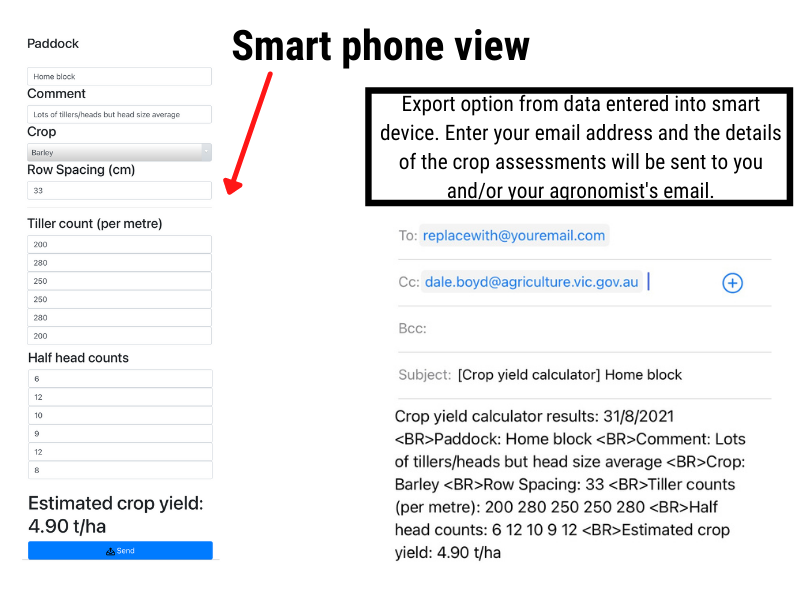Guide to estimating crop yields
An early estimation of grain yield is an important agronomy tool used in mid Spring. Farmers require accurate yield estimates for a number of reasons but after observing the crop grow over winter, this will be an opportunity to analyse paddock performance. Critical analysis during grain-fill will identify if projected yield estimates could be achieved or other agronomy issues are affecting the crop. Understanding moisture levels with the use of soil moisture probes at grain fill can assist in forecasting grain quality prospects and planning harvest logistics and storage requirements.
Extensive personal experience is essential for estimating yield at early stages of growth. As crops near maturity, it becomes easier to estimate yield with greater accuracy.
Estimation method
There are many methods available for farmers and others to estimate yield of various crops. Some are straightforward whereas others are more complicated. The method presented here is one that can be undertaken relatively quickly with the use of a ruler and easily entered into smart phones, eliminating the use of paper and pen that can get wet while in the crop. Immediate feedback on crop yield is produced and by assessing a number of paddocks it will become evident as to what factor/s are impacting the season and the crop.
- Choose a cereal paddock of wheat or barley and list the paddock name for your reference
- From the drop down menu, select the crop type of either wheat or barley
- Walk the paddock in your preferred sampling method and select six areas that are representative of the cropping area. Using a 50 cm measuring stick or tape measure, put this between a row and count the number of heads on both sides of the ruler (equalling the heads in a metre of row)
- This can be done more than six times to get an average of the crop but there is a capacity to record multiple counts in the estimator tool
- Pluck six heads while doing the head counts and count the number of flowers or grains per half head in at least six heads (attempting to get a representative sample of heads in the paddock (i.e., not all main stems but heads also from secondary tillers). Enter half head values in the spaces and be aware that it is easier for two row barley and can be a challenge to determine the final filling width of wheat. It’s obviously easier the further past flowering you are and can count developing grains. A floret factor is inbuilt into the calculator for wheat (see below)
- Record the row spacing in centimetres
- Take note of the yield and record agronomic comments of what was the key driver or limitation to yield; lodging/crop fallen over, disease of leaves/head, insect attack or weed population, general health (waterlogged, droughted, dry soil surface and patchy emergence) and whether this has influenced the number of tillers that produced heads of the filling capacity of the cereal head
- Take a screen shot of the paddock for your records or use the blue export button at the bottom to send all the details to your preferred email and/or your agronomist. Feel free to include [email protected] in the export of data as data points for yield are important compliments to the Soil Moisture Monitor dash board
For example, to calculate a barley yield:


Accuracy of yield estimates depends upon an adequate number of counts being taken so as to get a representative average of the paddock. The yield estimate determined will only be a guide and assumptions made from the estimates contain a degree of uncertainty.
Note – a floret factor for wheat is to allow for the over-estimating of wheat to fill all grains in the head.
Grain size estimation
Grain weights are expressed as weight per 100 grains (in grams). This is lower than a harvest or sowing seed sample grain size due to small grains that get blown out in the tailings.
Wheat 2.8g
Barley 3.5g
This type of yield estimation is one of the easiest and quickest to complete and should be able to be used in a number of situations in cereal paddocks. Grain losses both before and during harvest can be significant and could be in the range of 5 to 10 per cent.
Disclaimer
The content of this Victorian Government website is provided for information purposes only. No claim is made as to the accuracy or currency of the content on this site at any time.
The Victorian Government and this agency (Department of Jobs, Precincts and Regions) do not accept any liability to any person for the information or advice (or the use of such information or advice) which is provided on this website or incorporated into it by reference. No responsibility is taken for any information or services that may appear on any linked websites.


